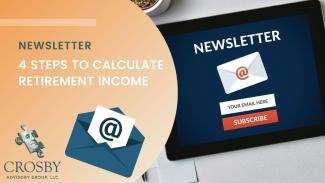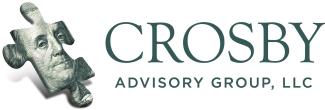
4 steps to calculate retirement income
Thinking about retirement? 4 steps to make sure you are ready
Step 1: What is your base retirement income needs? You should know how much you need each year to sustain your desired standard of living. We have found most people need at least 70% of their working income to meet demands in retirement.
Step 2: What is your social security or pension benefit? If you have spent the past several decades working, chances are you have either paid into social security or may be receiving a pension from your work. Know the annual amount you will receive from social security or a pension and subtract that from the sum you came up with in Step 1. Annual income needs - social security/pension = X. You can find your social security benefit at www.ssa.gov. Click on my social security to create an account.
Step 3: Bridge the Gap. For most people, social security or a pension is not enough to fully cover retirement income expenses. They must use personal savings and retirement accounts to fill the gap. As a general rule, if we have an investment account with at least 5 different asset classes, we can take a 5% withdrawal and expect the account to last more than three decades. So, a $500,000 retirement account would produce $25,000 per year. For a rough estimate of total retirement income, add 5% of your nest egg to your social security or pension benefit. There are ways in which we can squeeze more income out in retirement, but if you are looking for a ballpark figure, these steps will get you there.
Step 4: Analyze and Improve. Are you ahead of schedule or behind? Do you need to save more or work a few more years? Will you downsize expenses in retirement? Could a part-time job provide more freedom? These are questions to answer now before you give your final notice 😊!
Contact us to schedule a free consultation.
Where are we in the market cycle? Using last week’s rally to control risk
Two weeks ago, I was at a soccer tournament and parent of a player who works in the financial industry asked me if I thought the U.S. stock market had bottomed. He believed that we may have with stock valuations as low as they are. Unfortunately, we don’t expect stock prices to bottom yet for several reasons:
- QT (Quantitative Tightening) which is the intentional contraction of the money supply to slow down the economy. QT doesn’t effectively begin until June 15th when $15 billion dollars of Treasures mature and are set to roll off the Federal Reserve’s balance sheet. Massive money printing in 2020 and 2021 and supply chain constraints have led to high inflation which the Federal Reserve now says is their number one concern and prioritizes reducing inflation above all other mandates. The last time the Federal Reserve attempted QT was in 2018, which lead to significant destabilization stock prices.
- Valuations of stocks do look inexpensive, but we believe only when compared to 12-month trailing returns. We would not be surprised to see contractions in company earnings as interest rates continue to rise (cost of business becomes more expensive) and contraction of the money supply has time to constrain the economy.
- Inflation is like that annoying kid at the playground, it doesn’t take a hint and go away easily. We expect the pace at which prices are rising to decrease but we do not believe prices will decrease as fast as the Federal Reserve would like them to. I just paid $5.00 for gas for the first time in my 44-year life. We own the energy sector (XLE) in our risk-based models. While this can’t help us at the pump it can help our investment accounts.
- Russia’s invasion of Ukraine continues to impact food prices as well. Our risk-based models own Invesco’s agriculture fund (DBA) to attempt to take advantage of rising food commodity prices. Increased food prices may mean less discretionary spending.
We feel the bottom will occur when the environment is conducive for growth or stocks get too oversold relative to present earnings. This may happen if interest rates stabilize sooner than expected. We believe that is the less likely scenario with inflation being difficult to tame. It is our opinion the more likely reason for a bottom is a reversal in interest rate increases and/or QT. Eight (8) out of the last nine (9) times the Federal Reserve attempted to tame inflation by raising interest rates they tightened too far. As a result, our risk-based models remain very defensive holding energy, commodities, gold, consumer staples, and we are net short on the S&P 500 and Nasdaq 100. We used last week’s mini-rally to rebalance our risk-based strategies to attempt to capitalize on what we believe will be more negative volatility for stocks in the coming weeks. A key to investing is not to try to avoid market cycles, but rather understand where you are in the market cycle so you can act accordingly.
Is there a better day of the week to buy gas?
If you are like me, the answer is “when my car is empty,” but with some planning, some price experts say there are better times to fill up at the pump. GasBuddy’s De Haan said, “Though there is variation in daily gas prices across different states, the consensus is that filling up at the beginning or end of the work week, on Monday or Friday, is the best way to save money. Following Monday, Sunday is the cheapest day to fill up.” GasBuddy claims the most expensive day to fill up is Thursday, followed by Wednesday.
Looking to cut insurance costs? Improve your credit score
Today most insurance companies use credit score, at least in part, to determine how much you pay for auto and home insurance. If you have recently improved your credit score, ask your insurance agent to requote you. Chances are your premium will go down as your credit score goes up. Contact Julie Maglott for a free quote Julie@nmdinsurance.com.
In case you missed it, last week CAG Marketing’s own Carly Snyder talked with Malery Sloan about Social Media Marketing. You can check it out here.
Disclaimer: This newsletter represents the opinions of Crosby Advisory Group, LLC. Investing involves risk including potential loss of principal. Consider all risks and fees before investing. This newsletter is not intended to replace individual investment advice. Nate Crosby and Crosby Advisory Group, LLC have ownership interest in CAG Marketing and NMD Insurance.
Follow us on Social Media
Facebook: Crosby Advisory Facebook Instagram: Crosby Advisory Instagram

